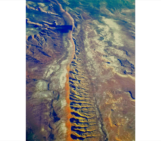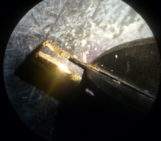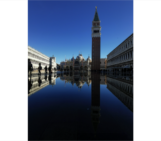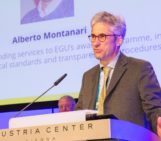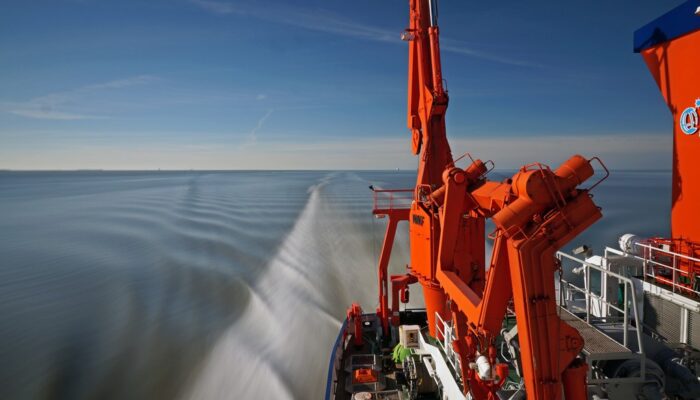
The picture was taken during the 2015 research cruise HE441 in the southern German Bight, North Sea. It features the research vessel Heincke, on a remarkably calm and warm spring day, forming a seemingly steady wake.
The roughly 55 metre long FS Heincke, owned by the German federal government and operated by the Alfred Wegener Institute, provides a great platform for local studies of the North Sea shelf. Eleven scientists and students from the University of Bremen, MARUM Research Faculty, University of Kiel, and Federal Waterways Engineering and Research Institute, along with the ship’s crew formed a great team under the supervision of chief scientist Christian Winter.
On deck, different autonomous underwater observatories were waiting to be deployed. Their purpose was to measure the seabed- and hydrodynamics in a targeted area of the German Bight. The investigation of the interaction between geomorphology, sedimentology and biogeochemistry is crucial to understand the processes acting on this unique and dynamic environment. In the German Bight various stakeholders with diverse interests come together. Profound knowledge, backed by cutting edge research, helps to resolve future conflicts between use and protection of the environment.
While this photo features a tranquil day at sea, some days later the weather and wave conditions got so bad that the cruise had to be abandoned. Storm Niklas, causing wave heights of more than three metres, made deployment and recovery of the observatories too dangerous for the crew, scientists, and delicate instruments.
Despite the severe weather, the research cruise was still able to gather important data with the time made available. Schedules on research vessels are tight and optimized to fit as much high-quality measurements as possible into time slots that are depending on convenient sea (tide) and weather conditions. State-of-the-art research equipment were prepared, deployed, recovered and assessed several times during the then only 8-day long cruise. Measurements were supported by ship based seabed mapping and water column profiling. Transit times, like the one depicted, were used to prepare the different sensors and instruments for the upcoming deployment.
The rare occasion of good weather combined with idle time was utilized to take this long exposure photo. A calm sea, a stable clamp temporarily attached to a handrail, and a neutral density filter were additionally required to increase the exposure time of the camera to 13 seconds, in order to capture this picture. The long exposure time smooths all movement relative to the ship, enhancing the effect of the wake behind the Heincke vessel.
Over the course of several years, regular Heincke research cruises and the collaboration between the different institutions has led to the successful completion of research projects, with findings being published in various journals, listed below.
By Markus Benninghoff, MARUM, University of Bremen, Germany
Further reading
Ahmerkamp, S, Winter, C, Janssen, F, Kuypers, MMM and Holtappels, M (2015) The impact of bedform migration on benthic oxygen fluxes. Journal of Geophysical Research: Biogeosciences, 120(11). 2229-2242. doi:10.1002/2015JG003106
Ahmerkamp, S, Winter, C, Krämer, K, de Beer, D, Janssen, F, Friedrich, J, Kuypers, MMM and Holtappels, M (2017) Regulation of benthic oxygen fluxes in permeable sediments of the coastal ocean. Limnology and Oceanography. doi:10.1002/lno.10544
Amirshahi, SM, Kwoll, E and Winter, C (2018) Near bed suspended sediment flux by single turbulent events. Continental Shelf Research, 152. 76-86. doi:10.1016/j.csr.2017.11.005
Krämer, K and Winter, C (2016) Predicted ripple dimensions in relation to the precision of in situ measurements in the southern North Sea. Ocean Science, 12(6). 1221-1235. doi:10.5194/os-12-1221-2016
Krämer, K, Holler, P, Herbst, G, Bratek, A, Ahmerkamp, S, Neumann, A, Bartholomä, A, van Beusekom, JEE, Holtappels, M and Winter, C (2017) Abrupt emergence of a large pockmark field in the German Bight, southeastern North Sea. Scientific Reports, 7(1). doi:10.1038/s41598-017-05536-1
Oehler, T, Martinez, R, Schückel, U, Winter, C, Kröncke, I and Schlüter, M (2015) Seasonal and spatial variations of benthic oxygen and nitrogen fluxes in the Helgoland Mud Area (southern North Sea). Continental Shelf Research, 106. 118-129. doi:10.1016/j.csr.2015.06.009
If you pre-register for the 2019 General Assembly (Vienna, 07–12 April), you can take part in our annual photo competition! From 15 January until 15 February, every participant pre-registered for the General Assembly can submit up three original photos and one moving image related to the Earth, planetary, and space sciences in competition for free registration to next year’s General Assembly! These can include fantastic field photos, a stunning shot of your favourite thin section, what you’ve captured out on holiday or under the electron microscope – if it’s geoscientific, it fits the bill. Find out more about how to take part at http://imaggeo.egu.eu/photo-contest/information/.
Imaggeo is the EGU’s online open access geosciences image repository. All geoscientists (and others) can submit their photographs and videos to this repository and, since it is open access, these images can be used for free by scientists for their presentations or publications, by educators and the general public, and some images can even be used freely for commercial purposes. Photographers also retain full rights of use, as Imaggeo images are licensed and distributed by the EGU under a Creative Commons licence. Submit your photos at http://imaggeo.egu.eu/upload/.

